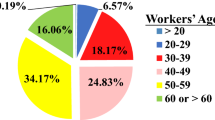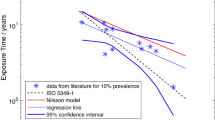Abstract
On the basis of data presented in our previous reports, the current study was undertaken to estimate frequency-weighted hand-arm vibration exposure limits for various daily exposure times. The procedures for the present study were as follows. (1) The prevalence of vibration-induced white finger (VWF) as well as the vibration exposure were investigated in various groups of workers operating hand-held vibrating tools. The vibration magnitude of various tools was measured and the results were presented as the energy-equivalent frequency-weighted root-mean-square (m/s2 rms) acceleration. There was a statistically significant positive correlation between the prevalence of VWF and the measured vibration magnitude (R 2=0.5, P<0.05). Hence, it was concluded that in decisions concerning quantitative recommendations for vibration exposure, the prevalence of VWF should be considered. (2) By a careful selection of available publications which contain useful information on duration of vibration exposure of ?2 h/day and the occurrence of VWF, a significant correlation between the prevalence of VWF and the vibration magnitude could be observed. The regression equation was estimated as: y=−18.5+4.6 (x), R 2=0.8. On the basis of this equation, it was speculated that the prevalence of VWF in workers using vibrating tools might be restricted to the prevalence of Raynaud’s phenomenon in the Japanese general population if the 2-h daily vibration exposure is about 4.5 m/s2 rms. (3) Regarding this speculation, the equation provided in the documentation of ISO 5349 was used and modified as: [(a h,w) eq,t =(a h,w)eq,2⋅ (2/t)1/2 (m/s2 rms)] and then the vibration limit values for daily exposure of 1 min to 8 h were calculated. (4) In order to achieve compatibility with standards of other countries, and to formulate an easy method for using the recommended values presented here, the daily exposure time of 8, 4, 2, 1 and 0.5 h were selected. The correspondence vibration magnitudes were in the range 2.2–9.0 m/s2 rms, and the lower limit (2.2 m/s2 rms) was assumed as the permissible vibration exposure limit for an 8-h working period. The proposed daily vibration limits were then compared with those recommended by other institutions.
Similar content being viewed by others
Author information
Authors and Affiliations
Additional information
Received: 31 May 1996/Accepted: 10 September 1996
Rights and permissions
About this article
Cite this article
Mirbod, S., Iwata, H. Proposal for hand-arm vibration exposure limits adopted for Japanese workers operating hand-held vibrating tools. Int Arch Occup Environ Health 69, 418–422 (1997). https://doi.org/10.1007/s004200050169
Issue Date:
DOI: https://doi.org/10.1007/s004200050169




